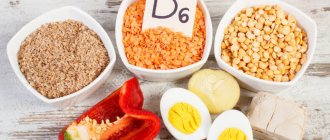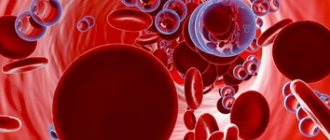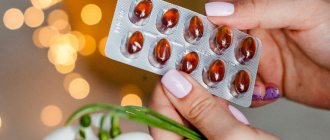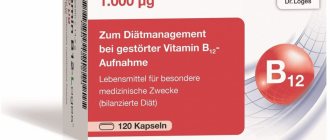Vitamin B4 (choline, trimethylethanolamine) is a thermostable amino alcohol, the so-called lipotropic factor, and is part of the B complex of vitamins.
For the first time, the compound was obtained from bile, which influenced the name of the substance: translated from Greek choly - “bile”. As a donor of specific methyl groups, it participates in the processes of remethylation associated with the formation of methionine, adrenaline, methylnicotinamide and other compounds, and is part of phospholipids.
Choline belongs to the category of water-soluble vitamin-like substances that affect protein and fat metabolism. Lack of the compound in the body leads to excess weight gain. Therefore, vitamin B4 is an indispensable component of complex therapy for weight loss.
The structural formula of choline is C5H15NO2.
The peculiarity of the vitamin-like substance B4 is the ability to be produced in the body. Thanks to this, in most cases, the internal organs and tissues of a person do not “experience” a lack of useful compounds.
Physicochemical characteristics
Vitamin B4 is an amino-ethyl alcohol, the structure of which includes three methyl groups of nitrogen atoms. The functional compound is constantly in an ionized state, which makes choline a strong base.
Content:
- Physicochemical characteristics
- History of discovery
- Metabolism of vitamin B4
- Biological role
- Signs and consequences of choline deficiency and excess
- Daily requirement
- Choline during pregnancy
- Medicinal use
- Sources of vitamin B4
- Choline in medicine
- Instructions for use of cholinomimetic
- Interaction with other substances
Trimethylethanolamine is a colorless substance with a distinct odor of trimethylamine. The presence of highly hygroscopic crystals ensures their easy transformation into a viscous liquid. Choline is highly soluble in anhydrous ethanol and water, less soluble in acetone, chloroform, amyl alcohol, and insoluble in carbon tetrachloride, benzene, diethyl ether, carbon disulfide, and aromatic hydrocarbons.
Vitamin B4 is relatively stable, the threshold of thermal stability of the compound is 180 degrees, an increase in temperature leads to its destruction. Treatment of the substance with hot alkali promotes the death of the choline molecule and the formation of trimethylamine. Trimethylethanolamine reacts with organic and inorganic acids, forming salts, for example, hydrochloric acid.
Acting as part of phospholipids, vitamin B4 is part of almost all cells of the body. Moreover, a larger amount of it is found in human plasma. The content of the compound in the blood depends on the season and varies from 6.1 to 13.1 micromoles per liter. The lowest amount of choline in the human body is observed in July, and the highest in February-March.
In women, trimethylethanolamine is excreted in menstrual blood. Depending on the phase of the cycle, the highest amount of choline is observed on the 14th day, the lowest on the 26th day. In addition, vitamin B4 is part of the cerebrospinal fluid.
The level of free choline in the human body is 77 - 216 nanograms per milliliter, total - 104 - 423, respectively. A high concentration of the compound is found in seminal fluid.
Vitamin B4, its esters and salts are used as a food additive registered under the E1001 sign. Choline is used in the food production process as a glazing agent and anti-flaming agent, preventing the formation of foam. In addition, the substance is used as an emulsifier during the creation of fat emulsions (sauces, chocolate, ice cream, margarine, mayonnaise). It is also used in baking bread, making cheese, frozen products, sausages, and baby food.
According to the conclusion of scientists, B4 is considered a harmless supplement that has a beneficial effect on the functioning of the nervous system and is called an anti-sclerotic vitamin.
Which choline is better
For those planning to take vitamin B4 to enhance cognitive function in the brain, it is preferable to use Alpha GPC or CDP-choline. But what kind of choline is best for an athlete to take - it depends on the type of sport, physical condition and goal. Selecting the type of choline supplement and determining an effective regimen is the responsibility of the trainer and sports physician.
Conclusion
Modern official medicine has convincing evidence that choline (vitamin B4) is an important substance for the development, preservation of health and maintenance of the quality of human life at all stages. Medicines containing choline should be prescribed by a doctor. Others can buy a choline supplement and take it as directed. Experience shows that they help young people learn better, older people retain memory, vegans avoid health problems, and athletes achieve better results.
History of discovery
The first mention of choline dates back to the 19th century (1862), when scientists discovered a useful compound while studying animal tissue. However, people realized the importance of the substance for the human body half a century later.
Experiments on animals carried out in 1930 were a decisive factor in the research of the vitamin-like substance. Thus, during the test, the pancreas was removed from experimental animals, after which insulin was administered artificially. For a long time, research did not bring the desired result. Despite the fact that the animals survived after surgery, they started the process of fatty degeneration of the liver, which eventually stopped working. As a result, everything ended in the death of the animals.
In the process of numerous studies, scientists identified the reason for this outcome; it turned out to be a lack of choline in the animals’ bodies. Due to a deficiency of the compound, the liver did not process fat, and as it accumulated, it led to the replacement of normal liver tissue with fatty tissue and the occurrence of cirrhosis.
In the human body, processes occur similarly.
Why do we need choline?
Choline ensures normal metabolism, optimal functioning of the intestines and other internal organs. Without vitamin B4, complete transmission of nerve impulses is impossible.
In addition, choline takes part in a number of important physiological processes:
- Renewal of the cellular structure of tissues after toxic injuries from both toxic substances and pharmaceuticals and drugs.
- Control of metabolism, fat excretion, reduction of cholesterol parameters.
- Prevents the destruction of nerve fiber cells.
- Activates the regeneration of the liver structure.
- Suppresses the formation of intraorgan stones.
- Reduces fatty acid levels.
- Participates in the production of methionine.
- Has a beneficial effect on myocardial function.
- Strengthens pancreatic cells responsible for producing insulin.
- Stimulates reproductive function.
- It has a beneficial effect on the condition of patients with diabetes.
[Video] Medical consultant of NPTsRIZ, geneticist, Ph.D. Irina Yuryevna Saburova talks about the mechanisms of action of choline:
Metabolism of vitamin B4
Choline is a nitrogen compound that is similar in chemical structure to ammonia. The mammalian body forms a substance from the amino acid methionine. In addition, B4 comes from food.
During processing, choline is partially destroyed by intestinal microflora, forming trimethylamine. If a person’s diet contains a low amount of a vitamin-like substance, it is absorbed by active transport, if a large amount is absorbed by diffusion.
As part of lipoproteins, partially free choline, phosphocholine from the intestine (with the blood) is distributed to the tissues. Subsequently, the substance is “included” in the course of metabolic processes.
Phosphocholine plays an important role in the synthesis of phosphatidylcholine (lecithin).
The ingested choline is excreted from the body by sweat, bile, and urine. Up to 1.5% of the substance is excreted daily with urine. With sweat – 0.01% of the total amount of B4 taken.
If the excretory function of the kidneys is impaired, the breakdown products of the compound slowly leave the body, which leads to increased azotemia. Contrary to popular belief, choline is not excreted in feces (with the exception of diarrhea).
Choline (phosphatidylcholine, vitamin B4)[edit | edit code]
Vitamin B4 content in some foods
Choline
(from the Greek kholy - bile) - belongs to the B vitamins (vitamin B4 or Bp), although animals and microorganisms are able to synthesize it. Choline salts bitartrate or phosphatidylcholine are often used in sports nutrition, although they do not provide benefits. Choline, phosphatidylcholine, and lecithin are completely interchangeable. Gliatilin (alpha-glycerylphosphorylcholine) also provides high bioavailability of choline.
Choline in food.
Its content is especially high in egg yolk (in the form of lecithin), brain, liver, kidneys and heart muscle. Found in cabbage, spinach, soybeans. During heat treatment it is partially destroyed.
Biological effects of choline[edit | edit code]
Choline is widely used in bodybuilding and other sports, as its many effects contribute to improved performance.
- In the body, the most important neurotransmitter-transmitter of nerve impulses, acetylcholine, is synthesized from choline.
- It is an important substrate for the nervous system and improves memory.
- Reduces homocysteine levels and protects the heart.
- Part of phospholipids (for example, lecithin).
- Participates in the synthesis of the amino acid methionine, where it is a supplier of methyl groups.
- Affects carbohydrate metabolism by regulating insulin levels in the body.
- Choline is a hepatoprotector and can therefore be used during a steroid cycle. As a donor of methyl groups, it participates in detoxification processes (detoxification of toxins).
Doses and regimen[edit | edit code]
Choline deficiency practically does not occur, since it comes in sufficient quantities from food and is produced by the body independently. However, during bodybuilding there is an increased need for choline, especially when taking steroids and other drugs that have a toxic effect on the liver. It should be noted that one chicken egg contains approximately 150 mg of choline (lecithin), so eating several eggs with yolks each day can completely eliminate the need for additional supplementation.
Under normal conditions, it is recommended to take approximately 0.5 g of choline; in bodybuilding conditions, the optimal doses increase due to the increased needs of the body to 1-3 g daily.
The maximum dose of choline is 3.5 g. In case of overdose (more than 10 g), the body begins to emit a fishy odor, nausea, depression, decreased blood pressure, sweating, increased salivation and indigestion may occur.
Biological role
Let's look at why choline is needed in the human body.
- Nervous system. The vitamin plays a key role in creating the protective sheath of nerves and phospholipids that make up cell membranes. The connection protects them, as well as the myelin layer, from partial damage and complete destruction, which can lead to “exposure” of neurons and disruption of the nervous system as a whole. Trimethylethanolamine is a metabolic precursor of an important neurotransmitter, the so-called acetylcholine, which is responsible for the transmission of impulses. The systematic intake of choline into the human body prevents the occurrence of disorders of the nervous system.
- Fat metabolism. The compound acts as a strong hepatoprotector, which helps accelerate the structural restoration of damaged liver tissue as a result of the toxic effects of alcoholic beverages, drugs, medications, and viruses. Choline prevents the formation of gallstones and improves the functioning of the digestive gland. Together with lecithin, it takes part in the transport and metabolism of fats in the liver, preventing its fatty degeneration (hepatosis). In addition, vitamin B4 promotes the absorption of vitamins E, K, A, D, normalizes fat metabolism, and accelerates the enzymatic breakdown of triglycerides.
- The cardiovascular system. Trimethylethanolamine cleanses the walls of blood vessels from cholesterol plaques, reduces the concentration of fatty acids in the blood and reduces the level of bad cholesterol. Vitamin B4 is involved in the formation of methionine, which “fights” excess homocysteine, which increases the risk of developing atherosclerosis, Alzheimer’s disease, and memory loss. In addition, choline normalizes heart rate and strengthens the heart muscle.
- Carbohydrate metabolism. The benefit of choline in the functioning of the pancreas is that the compound strengthens the membranes of beta cells, normalizes blood glucose levels by regulating insulin levels. The use of vitamin B4 in type I diabetes mellitus reduces the body's need for insulin. In type II disease, it compensates for the lack of polyunsaturated fatty acids in the body, reducing the excess level of pancreatic hormone, which in most cases is the main factor in the development of the disease.
- Reproduction. The most important functions of choline are increasing sperm motility and participating in the synthesis of prostaglandins in the prostate gland. In old age, vitamin B4 inhibits prostate dysfunction.
- Mental capacity. According to a test conducted at the end of the 20th century (a group of volunteers included 10 grams of B4 in their diet daily for 10 days), English psychophysicists came to the conclusion that the systematic use of choline improves the short-term memory of subjects.
Trimethylethanolamine is one of the most important building blocks for the brain. It is especially important to use the compound for children under 5 years of age and women during pregnancy, since it has been proven that the level of human intelligence is established in the womb and in the first years of a baby’s life, which means that a deficiency of choline during this period can lead to mental disorders in the development of the baby.
It turns out that vitamin B4 is a substance that helps preserve memory into old age, reducing the risk of sclerosis.
Until now, the phenomenal effect of choline on the course of processes in the brain has not been studied in detail. It is assumed that the compound slows down the aging process at the cellular level and helps build a kind of reserve - a strong network of neurons that process any information.
Thus, choline has a critical effect on the body. In addition to influencing the nervous, cardiovascular systems, reproductive function, mental abilities, carbohydrate and fat metabolism, it improves the physiological state of the body as a whole. Namely: it normalizes intestinal activity, regulates metabolism, has a positive effect on growth, triggers liver cell regeneration processes, promotes hematopoiesis, improves mood, and eliminates mental instability.
In the 1990s, scientists found that during the experience of severe emotional shock (stress), choline consumption doubles.
Remember, if there is a lack of vitamin-like substance B4 in the diet, a healthy body will still receive the vital compound by processing other foods. However, it is better to prevent this phenomenon from occurring and ensure a regular supply of the substance with food. Otherwise, the load on the body to transform the compound increases significantly.
Pharmacological action[edit | edit code]
While having the same effects as acetylcholine, choline is much less active. Even 10 g of choline when taken orally does not have a clear effect. Physiological functions. Choline performs several functions in the body. It is an important component of phospholipids, promotes the mobilization of fatty acids in the liver (lipotropic effect), serves as a donor of methyl groups and is necessary for the formation of the mediator acetylcholine (Chapter 6) and platelet activating factor (Chapter 26).
Phospholipid component[edit | edit code]
Choline is part of the main phospholipid - lecithin, plasmalogens (present in large quantities in mitochondria) and sphingomyelins (which the brain is especially rich in). Thus, choline serves as an essential structural component of many biological membranes and plasma lipoproteins.
Lipotropic action[edit | edit code]
As already mentioned, the important role of choline as a dietary component was first noticed in connection with its ability to reduce fat content in the liver of dogs with experimental diabetes mellitus. Substances that stimulate the removal of excess fat from the liver are called lipotropic. These include choline, inositol, methionine, vitamin B 12 and folic acid. Some of them apparently serve as donors of methyl groups in the synthesis of choline. As a result, the formation of lipid components of plasma lipoproteins occurs and the transport of fat from the liver is accelerated. A methyl group donor, choline can serve as a donor of (methyl)methyl groups necessary for the synthesis of other compounds. First, betaine is formed from choline, which is a direct donor of the methyl group. The methyl group can then be transferred to homocysteine, resulting in the formation of methionine. The role of vitamin B12 (cyanocobalamin) and folic acid in the metabolism of single-carbon compounds is discussed in Chap. 54.
Formation of acetylcholine[edit | edit code]
Acetylcholine is synthesized from choline and acetyl-CoA by choline acetyltransferase and broken down by AChE (Chapter 6). In the endothelium of the brain capillaries there is a system of facilitated diffusion of choline in both directions, and the amount of choline entering the central nervous system depends on its concentration in the plasma. When choline chloride is administered to rats, not only the concentration of choline in the plasma increases, but also the concentrations of choline and acetylcholine in the brain. These data may help in the treatment of diseases in which acetylcholine synthesis is reduced (see below). Synthesis of platelet activating factor. This factor is formed from choline-containing membrane phospholipids, in which at position 1 of the glycerol residue there is an alkyl ester instead of a fatty acid ester. Hormone-sensitive phospholipase A2 acts on the phospholipid, forming 1-O-alkyllisophosphatidylcholine. Under the action of a specific acetyl transferase, which catalyzes the transfer of the acetyl group from acetyl-CoA to position 2 of this intermediate product, platelet activating factor is formed. It plays an important role in inflammatory reactions and other processes (Chapter 26). Deficiency symptoms. Choline deficiency in animals is accompanied by fatty degeneration and cirrhosis of the liver, an increased risk of hepatic cell cancer, hemorrhagic kidney damage and impaired coordination of movements. Fortunately, none of these manifestations of choline deficiency have been observed in humans.
Signs and consequences of choline deficiency and excess
Characteristic symptoms of vitamin B4 deficiency in the body:
- noise in ears;
- depression, apathy;
- insomnia;
- irritability;
- frequent nervous breakdowns;
- headache;
- memory lapses;
- constipation;
- cardiac arrhythmia;
- state of fear;
- deterioration in concentration;
- constant fatigue;
- impaired milk formation during breastfeeding;
- sudden gain, retention of excess weight;
- decreased mental abilities;
- weakening of the immune system;
- impaired coordination of movements;
- weakness;
- increased cholesterol levels.
The appearance of at least a few signs may indicate the paucity of the daily diet for a beneficial compound. A negative reaction from the body can be eliminated by including foods rich in choline in the menu (see “Sources of the vitamin”) or through medication, by artificially adding the substance. The most common preparations containing vitamin B4 are Vitrum Beauty, Choline chloride, Duovit Memo. They are produced in ampoules or tablets.
Contraindications to the use of the drug: hypersensitivity to the components.
Vitamin B4 deficiency is caused by: lack of protein in the diet, physical overload, drinking strong drinks, antibiotics.
A long-term lack of trimethylethanolamine in the body leads to the following consequences:
- hypertension;
- atherosclerosis;
- circulatory disorders;
- slower growth in adolescents;
- a decrease in carotene synthesis, as a result of a slowdown in metabolism;
- obesity, liver dysfunction (cirrhosis, cancer);
- gastritis;
- disruption of the lactation process;
- oppression of the genital organs.
With prolonged “choline” starvation, the development of Alzheimer's disease is observed, accompanied by complete loss of memory. In addition, B4 deficiency in the body threatens mental disorders.
Thus, the above symptoms and consequences are a reason to consult a doctor about the use of choline. Timely therapy and treatment of the patient in most cases prevents the development of dangerous conditions and contributes to the restoration of human health.
An excess of the compound can harm the body, but does not lead to tragic irreversible consequences. Often, an overdose of vitamin B4 is accompanied by the following reactions: loss of appetite, fishy breath, increased blood pressure, diarrhea, excessive salivation and sweating, nausea. Typically, limiting your intake of foods high in choline will help quickly resolve these symptoms.
What functions does it perform?
Vitamin B4 (choline alfoscerate and choline bitartrate) is involved in most vital processes occurring in the body. The main ones:
- Cell formation. Choline is necessary for the synthesis of fats, which maintain the structural integrity of membranes.
- Signal transmission. Vitamin B4 is involved in the production of a component that ensures intercellular communication.
- DNA formation. Choline plays an important role in this process, along with folate (folic acid compounds) and vitamin B12.
- Lipid metabolism. Vitamin B4 is necessary for the production of a substance that prevents the accumulation of fats and promotes the elimination of cholesterol.
- Respiratory function. Choline is involved in the formation of surfactant, a component necessary for normal lung function.
- Activity of the nervous system. Vitamin B4 serves as a material for the synthesis of an important neurotransmitter - acetylcholine. This substance ensures the performance of such functions as thinking, cardiac activity, speech apparatus, muscle movement, etc.
For the normal functioning of all organs and systems, it is recommended to include foods rich in choline in the menu, as well as use dietary supplements based on it (see below).
Daily requirement
The daily intake of trimethylethanolamine is not regulated. However, the minimum requirement for a healthy person for the compound is 300 milligrams per day. Choline consumption directly depends on the amount of folic acid, protein, cobalamin (vitamin B12) in the body.
The daily dose of the vitamin-like substance B4 entering the body varies on average from 500 to 1000 milligrams per day.
The upper limit for consumption of the compound for children under 14 years of age is 2000 milligrams, for adults – 3500 milligrams.
In case of a stressful situation or high mental load, it is recommended to double the choline intake.
Choline bitartrate - features of administration
The most common form of choline is bitartrate (international name: choline bitartrate). This is a choline salt with high bioavailability (rate of absorption).
The average daily dosage of choline bitartrate ranges from 0.5 to 2 g. The exact dosage and duration of administration are determined individually. Choline is used as a nootropic to improve concentration and memory, as an antidepressant to increase resistance to stress and normalize sleep, and also as a restorative supplement that improves the condition of blood vessels, the function of the gastrointestinal tract and other body systems.
Please note that choline is not a drug and is not used to treat diseases. Individual contraindications are possible, so consultation with a doctor is required before use.
Choline during pregnancy
Remember, vitamin B4 is the most important nutrient for the normal ontogenesis of the fetus developing in the womb.
Choline is necessary as a substrate for DNA methylation in the child’s brain (due to the increased need for one-carbon residues), the construction of cell membranes (due to the rapid growth of tissues in both organisms), increasing the reserves of the compound in placental tissues, and increasing the production of lipoproteins.
The need for a useful substance is especially acute in the third trimester of pregnancy, when the myelin sheaths of fetal nerve fibers begin to be synthesized from sphingomyelin phospholipids.
Choline normalizes the psycho-emotional “background” of the mother by reducing the level of cortisol (stress hormone) in her body. This has a positive effect on the child’s nervous system (at later stages of life), protecting him from the onset of mental disorders and metabolic disorders. In addition, trimethylethanolamine stimulates the production of the neurotransmitter acetylcholine, which is “responsible” for the formation of synapses in the embryonic brain.
During pregnancy, the daily requirement of vitamin B4 is 1000 – 3000 milligrams. Retrospective studies of expectant mothers (case-control method) confirm numerous reviews from gynecologists about an increase (4 times) in the risk of having a child with neural tube pathologies when consuming a minimum portion of choline per day (400 milligrams) during pregnancy.
Interestingly, therapeutic doses of the vitamin can change fetal epigenetic markers that regulate the functioning of the endocrine gland. In this case, the hypothalamic-pituitary-adrenal system is stabilized, and as a result, the level of cortisol in the child’s blood decreases.
Vitamin B4 in combination with folic acid is an ideal prevention of neurological defects in the fetus, including childhood dementia. For this reason, in 1985, the American Academy of Pediatrics insisted on the introduction of an additional portion of vitamin B4 into infant formula (for every 100 calories - 7 milligrams of the substance).
Considering the fact that the brain of a newborn continues to actively develop in the first years of life, it is advisable for a nursing woman to take the nutrient during breastfeeding. At the same time, trimethylethanolamine, which enters the child’s body with milk, increases the concentration of its own choline in its blood. Scientists note that this component improves memory, cognitive and thinking functions in the children's brain.
Need[edit | edit code]
Tissues obtain choline from both exogenous (dietary) and endogenous (metabolic) sources. In the body, choline is synthesized by transferring the methyl group of methionine to ethanolamine or through a series of reactions requiring the presence of vitamin B12 and folic acid as cofactors (Chapter 54). Thus, to prevent fatty liver disease, it is necessary to consume sufficient amounts of methyl group donors in food. Large amounts of choline also have a therapeutic effect in some diseases of the nervous system, which is probably due to the stimulation of acetylcholine synthesis. However, none of the functions of choline gives grounds to classify it as a vitamin. It is not a cofactor of any known enzymatic reactions and produces therapeutic effects in gram doses far greater than the effective doses of any vitamin.
The daily requirement for choline is 550 mg for men and 425 mg for women (Table XIII.2). Americans on average consume 400-900 mg of choline per day as part of lecithin. Thus, it is difficult to imagine a diet lacking in choline. However, when methionine and folic acid intakes are low, choline deficiency can lead to biochemical signs of liver dysfunction, and therefore choline can be considered an essential dietary component in this situation (Jacob et al., 1999). The Committee on Nutrition of the American Academy of Pediatrics (1993) recommends adding choline to infant formula in an amount of at least 7 mg/100 kcal, which approximately corresponds to its concentration in human milk (9 ± 2 mg%).
Food sources[edit | edit code]
Choline is found in egg yolk, liver and peanuts (mainly in lecithin).
Medicinal use
Choline, along with improving fat metabolism and the functional state of the central nervous system, stimulates the production of red blood cells and increases the body's resistance to toxic substances. These properties of the vitamin are used in medicine to treat functional disorders.
Clinical uses of choline
Liver diseases
The lack of choline in the daily menu reduces the chemical synthesis of phospholipids (phosphatidylcholine and lipoprotein), as a result of which the outflow of fatty acids into the blood plasma is weakened. Because of this, triglycerides accumulate in the liver, which increases the risk of thrombosis. Vitamin deficiency leads to a decrease or cessation of the transport of fats to the peripheral tissues of the body. Moreover, at this stage, a laboratory examination reveals a normal level of triglycerides in the blood. Taking vitamin B4 in a therapeutic dosage (2000 - 3000 milligrams) helps prevent fatty infiltration of the liver, and in the presence of this pathology, accelerate the regeneration of degenerated tissues. Doctors suggest that trimethylethanolamine breaks down neutral fats and intensive excretion of phospholipids with bile begins in the diseased organ, which helps improve the functional state of the liver. In addition, oral administration of 100 milligrams of the substance per kilogram of body weight or parenteral administration of 1 milliliter of a 20% solution into a vein leads to intense bile secretion. This property of choline is used to reduce the increased production of phosphatase in patients suffering from liver cirrhosis. Daily intake of three grams of the substance for 15–20 days helps normalize organ function.
Heart pathologies
Vitamin B4 helps in the fight against “bad” cholesterol, as it dissolves deposits on the walls of blood vessels. This fact is confirmed by numerous studies, in particular, an experiment conducted by G. I. Koropova with the participation of 92 people. During the first month, patients were given choline chloride in combination with the amino acid methionine. After 30 days, patients showed positive dynamics in fat metabolism: a decrease in cholesterolemia, an increase in the content of phospholipids in the blood, and the release of fatty acids into the plasma (determined by analysis). When using vitamin B4 over the next 3–6 months, the detected changes had more pronounced symptoms. It is important to understand that the duration of choline therapy directly depends on the amount of “bad” cholesterol in the blood. In addition to dissolving atherosclerotic plaques, vitamin B4 increases performance, improves sleep, reduces headaches, prevents angina attacks, and normalizes intestinal evacuation function.
Neurology
Numerous studies confirm that mental health depends on the functional activity of the liver. Therefore, improving the functional state of the “filtering” organ by taking choline leads to normalization of emotional status, restoration of the balance of excitation and inhibition in the central nervous system, and resistance to adverse effects. In addition, lecithin (choline + inositol) is an essential nerve nutrient, as it makes up 30% of the brain and 17% of the peripheral nervous system.
Cognitive disorders
Choline is a substrate for the synthesis of lipids (phosphatidylcholine, sphingomyelin, lysophosphatidylcholine, choline-plasmalogen) and neurotransmitters (acetylcholine, signaling molecules), a donor of methyl groups necessary for the resynthesis of methionine and DNA methylation. Therefore, the substance is of enormous importance for the normal functioning of the brain. Laboratory experiments indicate the effectiveness of taking vitamin B4 in the complex treatment of cognitive disorders: decreased learning ability, concentration, memory and mental performance.
Cosmetology
Since phospholipids are the basis of cell membranes, their deficiency in the body, in 90% of cases, leads to disruption of the integrity of the dermis and deterioration of blood circulation in the tissues. To prevent these changes, including improving hair nutrition, it is important to take 500 milligrams of vitamin B4 daily. In addition, you can make your skin “lipostable” using cosmetics that contain choline (phosphatidylcholine). This phospholipid, when used externally, performs three functions: softening (emollient), restoration (repairant) and transport of nutrients to damaged tissues. The nutrient is also widely used in beauty salons as injections for skin rejuvenation (lipodissolution). Repeated injection of the solution into the subcutaneous fat in problem areas leads to the binding of the substance to lipoproteins, dissolution and removal from the cells. Before choosing “vitamin” cosmetics, it is important to carefully study the ingredient composition. The correct name of the substance in Latin is: 1,2-diacyl-glycero-3-phosphocholine, phosphatidylcholine, PtdCho and lecithin. Indications for the use of cosmetics with phosphatidylcholine: sensitive skin prone to redness, eczema, excessive dryness of the face, dysfunction of the hydrolipid mantle of the dermis, prevention of premature aging. The choline content in food has decreased sharply over the past 20 years, and the number of diseases associated with deficiency of the compound has doubled. To prevent the development of these conditions, it is advisable to take vitamin B4 in a prophylactic dosage of 500–900 milligrams per day, and for the treatment of functional disorders – 1000–6000.
What diseases does choline deficiency lead to?
Insufficient concentration of vitamin B4 in the body provokes the development of hepatosteatosis (non-alcoholic liver damage) and damage to muscle fibers []. Medical observation of a group of 57 adults showed that a decrease in choline in consumed foods led to the development of negative liver symptoms in 77% of men, 44% of premenopausal women and 80% of menopausal women [].
A study of postmenopausal women led to the conclusion that choline deficiency leads to damage to muscle tissue and the liver. These symptoms were recorded in 73% of study participants. The negative manifestations disappeared after the diet was adjusted [].
The intake of choline into the body of a pregnant woman is extremely important for the full formation of the child’s neural tube. Observations suggest that following a diet high in choline during the period of conception prevents the formation of neural tube defects in the fetus []. If during pregnancy a woman’s body lacks vitamin B4, the likelihood of developing preeclampsia, premature birth of the baby, and the baby becoming underweight increases [].
Of course, most people don't count the choline content of the foods they eat. The body of a healthy person has enough of its own vitamin and what it receives with food. For this reason, choline deficiency is extremely rare.
At-risk groups
Choline deficiency is most often detected in certain categories of patients:
- Pregnant women.
Observations by obstetricians and gynecologists indicate that at least 90-95% of all pregnant women receive less choline than they need []. A reduced concentration of choline is observed in the body of women during pregnancy and lactation when they do not receive additional folic acid. A lack of vitamin B4 in the blood is observed against the background of low levels of vitamin B12.
- Persons with genetic characteristics
. Changes in the structure of genes responsible for the metabolism of choline, methionine and folic acid negatively affect the synthesis and absorption of the vitamin [10-11].
- Patients receiving parenteral nutrition.
The use of total parenteral nutrition over a long period of time causes a decrease in the level of choline in the blood in children and adult patients. In children, these indicators are at least 5.7 nmol/ml, in adults - 5 nmol/ml. Deviations from the norm can cause obesity and liver dysfunction [12-13].
- Athletes involved in endurance sports.
Long-term endurance exercise, such as long-distance running, reduces choline concentrations [].
- Alcoholism
. Persons who drink alcohol frequently and in significant quantities suffer from choline deficiency. Signs of vitamin deficiency appear intensely with an inadequate diet [].
- Postmenopausal women.
Estrogens support normal choline production. A decrease in hormone levels causes the likelihood of a drop in the concentration of a vitamin compound [].
Sources of vitamin B4
To produce choline in sufficient quantities, the human body needs the following auxiliary substances: vitamin B12, glycine, methionine, serine, folic acid.
What foods contain these compounds?
Methionine and serine are found in cheese, eggs, fish, poultry and animals. Folic acid is found in cereals, brewer's yeast, vegetables, and fresh herbs, and vitamin B12 is found in the liver, heart, kidneys, milk, and cottage cheese.
Choline is found in many foods.
However, the largest amount of vitamin B4 is found in ingredients of animal origin, and less in ingredients of plant origin. The level of choline in eggs, milk, fish, meat, and dairy products is proportional to the content of phospholipids in them. Table “Which foods contain vitamin B2”
| No. | Name | Choline content, mg per 100 g of product |
| 1 | Egg powder | 900 |
| 2 | Egg yolk | 800 |
| 3 | Dry egg yolk | 800 |
| 4 | Beef liver | 635 |
| 5 | Pork liver | 517 |
| 6 | Quail egg | 507 |
| 7 | Chicken egg | 294 |
| 8 | Soybeans | 270 |
| 9 | Peas, shelled | 200 |
| 10 | Chicken liver | 194 |
| 11 | Quail | 150 |
| 12 | Turkey | 139 |
| 13 | Sour cream from 10 to 40% fat content | 124 |
| 14 | Ground mustard seeds | 122 |
| 15 | Duck | 119 |
| 16 | Chickens | 118 |
| 17 | Rabbit | 115 |
| 18 | Barley, oats (grain) | 110 |
| 19 | Fried tofu | 106 |
| 20 | Veal | 105 |
| 21 | Lightly salted mackerel | 101 |
| 22 | Dried coriander (cilantro) | 97 |
| 23 | Dried parsley | 97 |
| 24 | Lentils | 96 |
| 25 | Pink salmon | 95 |
| 26 | Fatty cold-smoked herring | 95 |
| 27 | Chickpeas | 95 |
| 28 | Durum wheat grain | 94 |
| 29 | Oat groats | 94 |
| 30 | Sorghum | 93 |
| 31 | Ordinary baking | 90 |
| 32 | Mutton | 90 |
| 33 | Simple dryers | 90 |
| 34 | Rusks made from wallpaper flour | 90 |
| 35 | Pistachios | 90 |
| 36 | Bagels | 90 |
| 37 | Sago | 90 |
| 38 | Nutmeg | 90 |
| 39 | Chinook | 89 |
| 40 | Wheat flour, second grade | 86 |
| 41 | Sour cream and garlic sauce | 85 |
| 42 | Rice, food grain | 85 |
| 43 | Crayfish | 81 |
| 44 | Shrimps | 81 |
| 45 | Wheat flour, wallpaper | 80 |
| 46 | Rice groats | 78 |
| 47 | Flax seeds | 78 |
| 48 | Chicken | 76 |
| 49 | By-products | 76 |
| 50 | Wheat flour | 76 |
| 51 | Pork | 75 |
| 52 | Wheat bran | 74 |
| 53 | Amaranth | 70 |
| 54 | Beans | 67 |
| 55 | Dried spirulina (algae) | 66 |
| 56 | Potato | 66 |
| 57 | Pike | 65 |
| 58 | Pumpkin seeds | 63 |
| 59 | Beluga | 56 |
| 60 | Sunflower seeds | 55 |
| 61 | Roasted peanuts | 55 |
| 62 | Dried basil | 54 |
| 63 | Paprika | 51 |
| 64 | Salo | 50 |
| 65 | Oyster mushrooms | 48 |
| 66 | Cauliflower | 44 |
| 67 | Dried thyme (thyme) | 43 |
| 68 | Boiled broccoli | 40 |
| 69 | Walnut | 39 |
| 70 | Sesame | 25 |
| 71 | Spinach | 22 |
| 72 | Avocado | 14 |
The table shows that the main source of choline is egg powder; a slightly smaller amount of the vitamin is contained in beef and pork liver. The smallest amount of the substance is found in fresh fruits and vegetables (apricot - 2.8 milligrams per 100 grams of product, sweet pepper - 5.5, grapes - 5.6, cucumbers - 6, nectarine - 6.2, tomato - 6.7, currants, mango, melon – 7.6 mg each, kiwi – 7.8, orange – 8.4).
Foods rich in choline lose some of the beneficial compound during heat treatment. When cooking meat and offal, the vitamin “evaporates” by 18%, plant foods - up to 40%, and when baking, the loss is 3%.
What products contain
Choline is found in plant and animal foods. The tables show the main sources of vitamin B4.
Food of animal origin:
| Product name | Choline content (mg/100 g) |
| Chicken yolk | 802 |
| Quail eggs | 506 |
| Beef liver | 419 |
| Beef kidneys | 322 |
| Chicken liver | 291 |
| Chicken eggs | 252 |
| Pork kidneys | 246 |
| Turkey | 138 |
| Duck | 117 |
| Mutton | 93 |
| Cod | 85 |
| Beef lean | 82 |
| Chicken without skin | 78 |
| Pork | 76 |
| Shrimps | 72 |
| Chicken with skin | 67 |
| Salmon | 66 |
| Mayonnaise (egg) | 47 |
| Dairy | 25-52 |
Plant food:
| Product name | Choline content (mg/100 g) |
| Sprouted wheat | 155 |
| Mustard seeds | 123 |
| Soybeans | 116 |
| Coffee (powder) | 104 |
| Rice | 85 |
| Wheat bran | 75 |
| Corn of milky ripeness | 72 |
| Oat bran | 59 |
| Peanut | 53 |
| Pasta | 52 |
| Chocolate | 47 |
| Cauliflower, broccoli | 42 |
| Wheat bread (the lower the grade, the higher the choline content) | 39-63 |
| Tomatoes, beans, peas, spinach, soy cheese (tofu) | 22-32 |
Choline and its derivatives - salts and esters - are used as very useful food additives.
Choline in medicine
Despite the fact that in 80% of cases lecithin is used as a source of choline, sometimes there is a need to take other types of nutrients.
Forms of release of vitamin B4
Choline citrate
The structure of the drug is identical to the structure of the molecules of the cell membranes of the brain. Thanks to this, it helps to quickly replenish vitamin reserves, which are intensively consumed during strength training. Choline citrate is primarily used to maintain the body’s energy needs in emergency cases (as an “ambulance”), improve psycho-emotional status, and increase performance and endurance in sports. Considering the fact that the “citrate” form of release improves the absorption of magnesium, it is advisable to use it for athletes who periodically experience muscle spasms. This medication is administered orally. Daily dosage – 250 – 900 milligrams.
Choline chloride
This drug is available in the form of a solution for intravenous administration and a powder for oral administration. It is prescribed to people suffering from atherosclerosis, hepatitis, Botkin's disease, liver cirrhosis (in the early stages), cystinuria, hypothyroidism and chronic alcoholism. Directions for use: 1% solution is administered through a dropper at a rate of 30 drops per minute. Single injection of liquid product – 200 – 300 milliliters. Remember, during intravenous administration, choline chloride can cause the following body reactions: nausea, vomiting, fever, heaviness in the head, bradycardia, decreased systolic pressure. These phenomena arise due to excitation of the parasympathetic nervous system. If these symptoms appear, administration of the drug should be stopped immediately. If it is necessary to take the medicine for a long time, as a rule, the powder is prescribed in the form of a 20% solution, which should be consumed in 5 milliliters 3 to 5 times a day. Course duration is 7 – 10 days.
Choline alphoscerate
A nootropic drug that activates cholinergic receptors in the postganglionic endings of the parasympathetic nerves. Choline alfoscerate, under the influence of brain enzymes, is broken down into free vitamin B4 and glycerophosphate. The first substance helps synthesize acetylcholine and improves the functioning of the central nervous system, and the second is converted into phosphatidylcholine, which increases the plasticity of neuronal membranes. Since the drug contains metabolically protected choline (40.5%), it is used to improve brain function.
Types of Choline
Today, vitamin B4 is not only available in foods. You can compensate for its deficiency or receive an additional dose by taking biologically active food supplements containing it. In the treatment of liver pathologies, drugs containing choline chloride are used. In addition, choline and its esters are also used in the food industry and are registered as additive E1001.
Lecithin / Lecithin
Healthy lifestyle experts advise girls and women to take soy lecithin. In addition to choline and amino acids, it contains phytoestrogens (isoflavones) necessary for the female body, substances that also improve the functioning of the thyroid gland, the condition of the skin, hair and nails.
Children before puberty, young men and men are recommended to use sunflower lecithin. Firstly, the stronger sex does not need phytoestrogens. Secondly, sunflower lecithin has a more powerful hepatoprotective effect, strengthens the heart much better and is less allergenic.
Daily lecithin intake (in 2 doses, before breakfast and before dinner):
- men - 6 g;
- women - 5 g;
- those involved in fitness - 10 g;
- professional athletes (during preparation and participation in competitions) - 12 g or more.
The recommended amount of lecithin for expectant and breastfeeding mothers is 12 g, which should be taken 3 g, 4 times a day.
Choline Bitartrate
Choline bitartrate is the most common, easily absorbed, and cheapest form of vitamin B4. It can be prescribed to restore liver cells, improve the condition of blood vessels, memory, concentration, increase stress resistance, and normalize sleep. Choline bitartrate is also taken by bodybuilders who take steroids.
Choline Citrate
It is believed that this type of choline is more effective, since in combination with bitartrate its content is 41%, and in combination with citrate it is 50%. Choline citrate helps athletes increase training performance and improve all indicators of endurance. In addition, citrate itself improves the absorption of magnesium, which is important for athletes who are plagued by periodic muscle spasms. It has also been noted that choline citrate helps to quickly master new movements and consolidate muscle skills.
The recommended daily intake of choline citrate during active training before competition is 1-3 g. Citrate powder is too acidic, so it should be added to a sweet drink, mixed with liquid honey or condensed milk.
Citicoline (CDP-Choline)
Citicoline is an expensive form of dietary supplement that consists of 19% choline and 81% cytidine. The latter substance, once in the body, quickly turns into uridine. It has powerful nootropic effects and increases the production of norepinephrine and dopamine. CDP-choline is taken to improve the quality of learning. It improves cognitive functions of the brain well after injuries, strokes, and Alzheimer's and Parkinson's diseases.
Alpha GPC / Alpha GPC
This dietary supplement, which consists of 40% choline, will help activate and increase the synthesis of acetylcholine, improve memory and slow down progressive neurodegenerative processes in the brain. In sports practice, Alpha GPC will help increase explosive power and muscle strength. This type of choline is also taken after exercise to stimulate growth hormone production.
Instructions for use of cholinomimetic
Best materials of the month
- Coronaviruses: SARS-CoV-2 (COVID-19)
- Antibiotics for the prevention and treatment of COVID-19: how effective are they?
- The most common "office" diseases
- Does vodka kill coronavirus?
- How to stay alive on our roads?
Indications: confusion, chronic cerebrovascular insufficiency, memory impairment, dementia (senile, Alzheimer's, post-stroke), emotional instability, senile pseudomelancholia, irritability, ischemic stroke (in the recovery phase), Huntington's chorea, traumatic brain injury (acute period), functional central nervous system disorders, decreased concentration, disorientation, cognitive disorders (with encephalopathy and dementia).
How to take choline alfoscerate?
In acute conditions (ischemic stroke, traumatic brain injury), 1000 milligrams of the substance are administered intravenously or intramuscularly (slowly). The frequency of injections, depending on the patient’s condition, is 1 – 4 times a day. The course of treatment is 10 – 20 days. After this, they switch to oral administration of the substance (3 capsules per day) for 4 to 6 months.
For dementia syndromes and chronic diseases of the central nervous system, the drug is prescribed orally, 400 milligrams 3 times a day before or after meals. The course of therapy is 3 – 6 months. If nausea occurs, reduce the dosage.
While carrying out “vitamin” therapy, it is important to consume protein foods that contain methionine (eggs, cottage cheese, liver, fish).
Remember, it is advisable to entrust the choice of medicine to an experienced specialist.
The above-described technologies for using drugs should not be taken as a basis; the material is for informational purposes only.
Indications for use
Choline preparations are prescribed for a number of conditions:
- Traumatic brain injuries, disorders of consciousness, coma.
- Acute cerebrovascular accidents. Condition after an ischemic or hemorrhagic stroke.
- Psychoorganic diseases associated with degenerative and involutional processes. Insufficiency of cerebral vessels, expressed in the form of memory impairment, disorders of consciousness, disorientation, attention disorder, motivation.
- Disorders of behavior and emotional state - irritability, emotional instability, loss of motivation, interests, senile pseudomelancholy, dementia.











